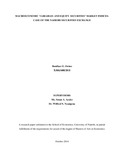| dc.description.abstract | The purpose of this study was to determine the short-run and long-run effects of domestic and
European Union’s macroeconomic variables on the Nairobi Securities Exchange’s 20-share
index using co-integration tests, Granger causality tests, and the VECM. The study used monthly
time series data covering the period 1993 to 2013. The dataset included Kenya’s 91-day Treasury
bill rate, inflation rate, and the NSE 20-share index, as well as, EU’s inflation rate, quantity of
money (M3), industrial production index, and the FTSE 100 index (UK). The Augmented
Dickey Fuller (ADF) tests revealed that the variables were non-stationary i.e. I(1) in their levels,
but stationary in their first difference. The Johansen-Juselius co-integration test showed that the
variables had a long-run relationship i.e. co-integrated. Granger causality tests revealed
unidirectional causal relationships running from Kenya’s 91-day T-bill rate and EU’s M3 to the
NSE 20-share index. Similarly, the NSE 20-share index Granger caused EU’s inflation rate and
industrial production index. The VECM results showed that the 91-day T-bill rate had a negative
and significant effect on the NSE 20-share index in the short run. EU’s M3, industrial production
index, and the FTSE 100 index had a positive and significant effect on the NSE 20-share index in
the short-run. In the long-run, EU’s industrial production index, and Kenya’s 91-day T-bill rate
had a positive effect on the NSE 20-share index. By contrast, EU’s M3 and the FTSE 100 Index
had a negative effect on the NSE 20-share index. Overall, the NSE converges to its long-run
equilibrium in 36 months. In light of these findings, investors at the NSE should take into
account changes in both Kenya’s and EU’s macroeconomic variables in their investments’
decisions. | en_US |

